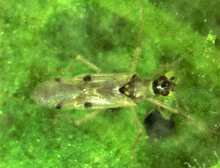Tupiocoris notatus
| Tupiocoris notatus | |
|---|---|
 | |
| Tupiocoris notatus adult | |
| Scientific classification | |
| Kingdom: | Animalia |
| Phylum: | Arthropoda |
| Class: | Insecta |
| Order: | Hemiptera |
| Suborder: | Heteroptera |
| Infraorder: | Cimicomomorpha |
| Superfamily: | Miroidea |
| Family: | Miridae |
| Subfamily: | Mirinae |
| Genus: | Tupiocoris |
| Species: | T. notatus |
| Binomial name | |
| Tupiocoris notatus (Distant, 1893)[1][2] | |
| Synonyms | |
Tupiocoris notatus is a sap-sucking bug in the family of Miridae. It feeds on mesophyll cell contents of solanaceous plants like Datura and Nicotiana-species. The insect is about 2 – 3 mm long and, like all hemipterans, undergoes an incomplete metamorphosis with several nymph stages.

Tupiocoris notatus nymph
It is distributet mainly in the southern continental US and Mexico but also the Caribbean, Middle- and South America.[2] This organism is used in research as a model organism in the field of chemical ecology to study plant-herbivore interactions between this insect and plants like Datura wrightii[3] or the model plant Nicotiana attenuata.
References
- 1 2 3 "Encyclopedia of life - T. notatus". Encyclopedia of life. Retrieved January 8, 2013.
- 1 2 3 "ITIS Standard Report Page - T. notatus". ITIS. Retrieved January 8, 2013.
- ↑ Van Dam, N. M.; Hare, D. J. (1998). "Differences in distribution and performance of two sap-sucking herbivores on glandular and non-glandular Datura wrightii". Ecological Entomology. 23: 22. doi:10.1046/j.1365-2311.1998.00110.x.
This article is issued from Wikipedia - version of the 8/29/2015. The text is available under the Creative Commons Attribution/Share Alike but additional terms may apply for the media files.